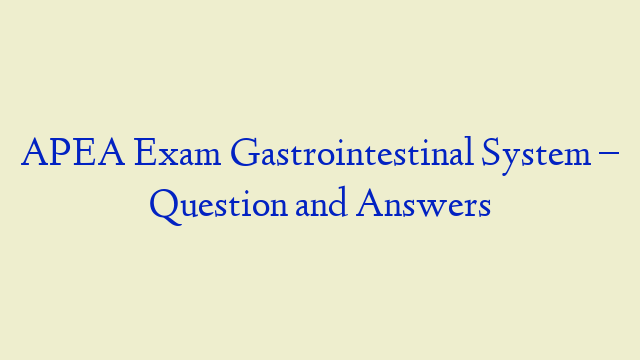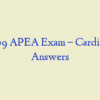Description
APEA Exam – GASTROINTESTINAL SYSTEM
- When performing a rectal exam, a tender, swollen, bluish ovoid mass is noted at the anal opening. This finding is most likely a(n):
- Risk factors associated with Hepatitis B include all of the following except:
- On auscultation of the abdomen, rushes of high-pitched sounds are audible and coincide with abdominal cramps. These findings are most consistent with:
- Which one of the following symptoms is seen in infants with pyloric stenosis?
- An enlarged liver with a smooth tender edge may suggest:
- When examining the buttocks and rectum, a small tuft of hair surrounded by a halo of erythema was observed as the sacral area. This finding is most likely:
- If abdominal pain persists when the patient raises his head and shoulders, the origin of the tenderness is probably:
- Bowel sounds may be increased in the presence of:
- Ecchymosis of the abdominal wall is usually seen in persons with:
- When percussing the right upper quadrant of the abdomen, a dull medium-pitched sound is heard. The area being percussed is probably the:
- A patient presents with complaints of burning sensation in the sternal area. He states it is aggravated by alcohol, chocolate and coffee. This finding is:
- A patient presents with symptoms of bloody stools, new onset constipation, and weight loss. These symptoms could be associated with:
- A patient was recently diagnosed with gluten intolerance and needs instructions on what foods to eat. The patient should be told that a gluten restricted diet includes:
- A feeling of constantly needing to pass stool is termed:
- Peritoneal inflammation produces abdominal pain and tenderness. What technique can be used to assess a tender abdomen suspected to be secondary to peritoneal inflammation?
- Signs and symptoms associated with diabetic gastroparesis may include all of the following except:
- Indicators of oropharyngeal dysphagia include all of the following symptoms except:
- A 30-year-old patient complains of frequent belching, pain in the area below the sternum mostly after eating, and increased salivation. These symptoms are often seen in patients who have:
- When assessing the liver, have the patient inhale while palpating:
- When performing a rectal exam, a purulent bloody discharge mixed with fecal matter is oozing from the rectum. This finding is most consistent with a: anorectal fistula
- A 40-year-old female presents with generalized abdominal pain and nausea. During the abdominal exam she exhibits inspiratory arrest with deep palpation on the upper right quadrant of the abdomen. This maneuver exhibits a positive: Murphy’s sign
- Which one of the following symptoms associated with gastroesophageal reflux (GERD) is considered an alarm symptom?
- Stools that are pencil-like in shape are most likely:
- Palpation of the liver reveals an enlargement that is firm with an irregular edge. This finding may be suggestive of:
- Spider angiomas, palmar erythema, and Terry’s nails can be associated with:
- A positive obturator sign would elicit pain in the:
- Which of the following symptoms are indicators of dehydration in a four-year-old child?
- When performing an examination of the rectal area, a linear tear at the anal opening was observed. This could be indicative of:
- Risk factors associated with Hepatitis A include all of the following except:
- A term used to describe induced vomiting without nausea is:
- On examination of the abdomen, loud rumbling noises are audible without a stethoscope. These sounds are termed:
- A patient visits the nurse practitioner for complaints of passing bloody stools over the past few weeks. He denies abdominal pain of fever. Further questioning revels that when he passes stool, he notices blood dripping in the toilet. These symptoms could be consistent with:
- Which type of hepatitis virus can be acute and subside without treatment? Hepatitis A
- A patient complains of severe epigastric pain that radiates to the posterior trunk and entire abdomen. This type of pain can be suggestive of:
- Which type of hepatitis is typically contracted by ingestion of contaminated food or water?
- A patient presents with chest pain and moves his hand from the neck to the epigastrium. This gesture could be suggestive of an:
- Examination of the abdomen reveals a protrusion through an operative scar. This finding may be suggestive of an:
- A 30-year-old male presents with general abdominal pain. With flexion of the legs at the hip an increase in his abdominal pain is noted. This finding elicited a positive:
- Stool that appears bloody, mucoid or with pus, may indicate:
- When inspecting the abdomen of a 60-year-old male, dilated veins were noted especially in the mid and upper abdomen. This condition is associated with: hepatic cirrhosis
- Stools that appear black, tarry, and sticky are referred to as:
- Acholic stools are associated with:
- Which of the following assessment findings is a result of the presence of a stone in the common bile duct?
- A patient is experiencing a dull achy pain in the epigastric area with eating. This type pain is consistent with:
- When performing a rectal exam, the examiner should:
- A patient complains of an unpleasant abdominal fullness after a light meal. This complaint may be consistent with:
- Helminths can be transmitted by:
- A patient presents with right upper quadrant and upper abdominal pain. Acute cholecystitis is suspected because the pain radiates to the:
- In the abdominal assessment of a 2-year-old, which one of the following would be considered abnormal?
- A 9-month-old who has been a healthy, thriving infant presents with a poor appetite, two episodes of vomiting, three bloody stools with mucus and knees drawn to the abdomen with screaming. These are clinical manifestations of: intussusception
- Abdominal percussion is performed to assess:
- When performing a rectal exam, if the anal sphincter presents with laxity, consider:
- If a patient describes his stools as thin and “pencil-like”, this could be associated with:
- A term used to describe the raising esophageal or gastric contents to the esophagus or mouth without nausea or retching is:
- Which type of hepatitis is most commonly transmitted from infected mother to infants at the time of birth?
- When there is a sudden obstruction cause by a gallstone in the common bile duct or the cystic duct, the pain is usually felt in the:
- Pain of the biliary tree origin may referred to the:
- When performing a rectal exam, a firm mass with an irregular border is palpated approximately two inches inside the rectum. This finding could be indicative of: rectal carcinoma
- Which is NOT a mode of transmission for hepatitis C?
- To perform deep palpation of the abdomen:
- When examining the abdomen, which of the following symptoms would be suggestive of appendicitis?
- When percussing a protuberant abdomen, tympany is audible. This is consistent with all of the following conditions except:
- Examination of the abdomen reveals a small midline protrusion in the linea alba. This finding is consistent with an:
- Which of the following food choices is the most appropriate to offer a teenage with celiac disease?
- Bowel sounds may be decreased in the presence of:
- A 35-year-old male visits the nurse practitioner for complaints of fullness in his lower abdomen. He states that he noticed it a few days ago when he was working out in the gym. At times it feels like a round lump in his groin. Examination reveals a protrusion under the skin near the right groin area. This finding could be suggestive of an:
- Which one of the following procedures would confirm the definitive diagnosis of Hirschsprung’s disease?
- During palpation of the abdomen, right lower quadrant pain is elicited by applying pressure to the left side of the abdomen. This technique elicited a positive: Rovsing’s sign
- A patient presents with complaints of black tarry stools for the last week. This symptom is seen in conditions related to the:
- Symptoms of a child suspected of having a diagnosis of mixed failure to thrive (FTT) are usually seen in children:
- When performing a rectal exam, a tender, purulent, reddened mass was noted at the anal opening. This finding is most consistent with a:
- Pain of the duodenal or pancreatic origin may be referred to the:
- When performing a rectal exam, a reddish, moist, protruding mass is noted at the anal opening. This finding is most likely a(n):
- A patient presents with complaints of bright red stools over the past week. This symptom could be consistent with:
- A 55-year-old patient visits the nurse practitioner for an annual exam. Stool sample revealed hematochezia. The patient is otherwise asymptomatic. This finding could be associated with:
- When performing a digital rectal exam, a soft, pedunculated lesion is palpated. This finding is most likely:
- An enlarged liver with a firm, nontender edge may be suggestive of:
- Which one of the following symptoms is associated with biliary atresia in an infant?
- Lower abdominal pain accompanied by fever or shock in older adults could be consistent with:
- Percussion of the abdomen should be avoided when:
- A general term for distress associated with eating is:
- What is the most commonly reported sexually transmitted disease (STD) in the United States?
- A patient was instruction to point to the location of his pain. He pointed to just below the sternoclavicular notch which likely indicates:
- The most appropriate position for the patient when performing a rectal exam and one that allows for optimal examination, is the:
- A 70-year-old patient states that he has some bright red blood on the toilet tissue this morning after a bowel movement. He denies pain. What is the LEAST likely cause in this patient?
- A 79-year-old with an appendicitis is unlikely to exhibit:
- The most common cause of diarrhea in adults is:
- An 83-year-old patient is diagnosed with diverticulitis. The most common complaint is:
- A patient is 86 years old and functions independently. He has hypertension, BPH, and flare-ups of gout. His last colonoscopy was at age 76 years. What should he be advised about having a colonoscopy?
- The two tests that can indicate current infection with hepatitis B are:
- A 26-year-old female complains of pain at McBurney’s point. She feels nauseated. Her vital signs are provided. The most appropriate initial action by the NP is to:
- Older adults frequently complain of constipation. Which medication listed below does NOT increase the likelihood of constipation in the older adult?
- A 20-year-old female patient presents with tenderness at McBurney’s point. Appendicitis is considered. What laboratory test should be done initially to determine the etiology of this patient’s abdominal pain?
- Serum pregnancy test
- Most patients who have acute hepatitis B infection:
- A patient has hepatitis B. he probably has a predominance of:
- A patient with diarrhea has a stool specimen positive for WBCs. What is likely etiology?
- A patient has been diagnosed with hepatitis A. The most common reported risk factor is:
- A 58-year-old patient has an annual exam. A fecal occult blood test was used to screen for colon cancer. Three were ordered on separate days. The first test was positive; the last two were negative. How should he nurse practitioner proceed? Refer him for a colonoscopy
- What choice below is most commonly associated with pancreatitis?
Gallstones and alcohol abuse
- An 84-year-old presents with a stated involuntary weight loss. He states that he’s lost about 6 pounds in the last 6 or 8 weeks. What statement below is NOT part of the assessment?
- An 82-year-old adult has constipation. A supplement known to cause constipation is:
- A 50-year-old with a history of consummation of 3-4 alcoholic drinks daily and weekend binges has elevated liver enzymes. Which set of enzymes is most representative of this patient?
- The relationship between colon polyps and colon cancer is that polyps:
- The most common reason that older adults develop peptic ulcer disease is:
- An older adult has osteopenia. Her healthcare provider has recommended calcium 500mg three times daily. What is the most common side effect of calcium supplementation?
- A patient with diarrhea is tested for C. difficile. How soon should the enzyme immunoassay (EIA) yield results?
- The relationship between a duodenal ulcer disease and H. pylori infection is:
- An 85-year-old adult has chronic constipation. How should this be managed initially?
- Most patients who have acute hepatitis A infection:
- An 85-year-old adult has chronic constipation. What is the most likely cause of her constipation?
- A 63-year-old male has been your patient for several years. He is a former smoker who takes simvastatin, ramipril and aspirin daily. His blood pressure and lipids are well controlled. Hs presents to your clinic with complaints of fatigue and “just not feeling well” for the last few days. His vital signs and exam are normal, but his liver enzymes are elevated. His hepatitis panel are negative for infectious hepatitis. What is the most likely care of his elevated liver enzymes?
- Which medication listed below can exacerbate the symptoms of GERD?
- A 6-week-old infant is brought to the nurse practitioner because of vomiting. The mother describes after feeding and feeling a “knot” in his abdomen especially after he vomits. The child appears adequately nourished. What is the likely etiology?
- A patient has received a prescription for metronidazole for treatment of C. difficile. What should be avoided in this patient? alcohol
- A 42-year-old patient was diagnosed with ulcerative colitis many years ago. What part of his routine health screenings should be stressed by the nurse practitioner?
- A 26-year-old female presents with concerns about possible hepatitis C (HCV) infection. She admits to IV drug use 2 months ago and sharing needles with several other people. Initial laboratory studies have been completed. How should this be managed?
- Which medication may be used to treat GERD if a patient has tried over the counter ranitidine without benefit?
- Which of the following symptoms is typical of GERD?
- What is the simplest screen for nutritional adequacy in elderly patients?
- A patient with suspected inguinal hernia should be examined:
- Which imaging study of the abdomen would be LEAST helpful in diagnosing an acute appendicitis
- What medication listed below could be used to increase appetite in an anorexic patient?
- A 70-year-old presents to the nurse practitioner’s office for a well exam today. What medications probably has no effect on screening for occult blood in the stool?
- A patient with gallbladder disease has classic symptoms. Which symptom below is NOT classic of gallbladder disease?
- Which is NOT an effective strategy for helping older adults gain weight?
- What is true regarding older adults who are overweight? Mortality in older adults related to overweight states declines over time
- A patient asks for advice about a medication that will produce rapid relief if he is having heartburn symptoms. What should the nurse practitioner recommend? Calcium carbonate
- A patient is in the clinic with a 36-hour history of diarrhea and moderate dehydration. Interventions should include:
- The most common symptoms associated with gastroesophageal reflux disease (GERD) are heartburn and:
- A fecal occult blood test (FOBT) obtained during a rectal examination:




